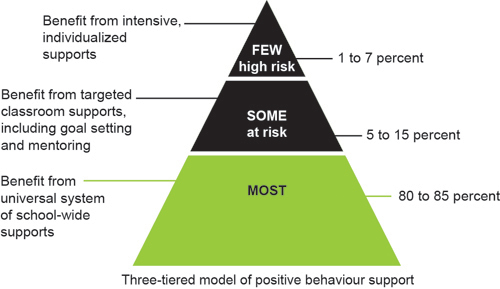|
Table of Contents
|

Drawing on current research and best practices, this three-part resource, Supporting Positive Behaviour in Alberta Schools, provides information, strategies, stories from schools and sample tools for systematically teaching, supporting and reinforcing positive behaviour. This integrated system of school-wide, classroom management, and individual student support is designed to provide school staff with effective strategies to improve behavioural outcomes in their school. The goal of this approach is to facilitate academic achievement and healthy social development of students in a safe, supportive learning environment. Behaviour issues in schools can interfere with learning, instruction and positive school climate. Not all students come to school ready to learn. Some students, for a variety of reasons, may not understand acceptable social behaviour and be unable or unwilling to meet the school’s behavioural expectations. The following pyramid model illustrates the behavioural issues in a typical student population. Studies show that 80 to 85 percent of students generally meet the school’s behavioural expectations. Another 5 to 15 percent chronically do not meet expectations and are at risk of developing severe behaviour disabilities. One to 7 percent have behaviour disabilities severe enough that they cannot meet behavioural expectations without intensive, individualized interventions.
The three tiers of this model represent a continuum of increasingly intense interventions that correspond to the responsiveness of students.
This three-part resource, Supporting Positive Behaviour in Alberta Schools is organized around this model. The three sections deal with:
A school-wide approach to positive behaviour supportsA school-wide approach to positive behaviour supports effectively promotes a safe, orderly and predictable environment for learning and teaching. This approach has significant effects within the school community: it creates a positive school culture that students, parents and staff perceive as safe and caring. Creating safe and caring schools is a professional obligation of teachers, mandated by the Alberta School Act (RSA 2000): “A board shall ensure that each student enrolled in a school operated by the board is provided with a safe and caring environment that fosters and maintains respectful and responsible behaviours” [Section 45(8)]. Creating a safe and caring school requires a team effort and a problem-solving approach. This resource, Supporting Positive Behaviour in Alberta Schools: A school-wide approach, describes a comprehensive school-wide approach that involves all students, all staff and all school settings. It is a flexible process for identifying the specific behavioural needs of individual schools and then developing an action plan to meet those needs. The focus of this approach is on establishing, maintaining and reinforcing the positive behaviour of the majority of students by providing clear expectations, but it also addresses problem behaviour. Although students in the at-risk category (less than 15 percent of the total school population) benefit from clear expectations and other universal supports such as positive reinforcement and active supervision, they often need additional supports such as targeted social skills training and mentoring. A school-wide approach also helps staff clearly identify the one to seven percent of students who demonstrate high-risk behaviour, and need intensive, individualized interventions and support on an ongoing basis. Positive behaviour supports create a structure, and they provide tools and strategies for school staff to positively affect how students behave and interact with one another. Students are reinforced for behaving in socially acceptable ways and encouraged to carry this learning and positive behaviour into their homes and the larger community. These are some of the indicators that might cause school staff to either adopt a school-wide approach to positive behaviour supports, or take steps to improve current school-wide systems.
|



